Bringing The Cheetah Back To India
First published in Sanctuary Asia,
Vol. 42
No. 12,
December 2022
By Dr. Y.V. Jhala
After scientific evaluation and site selection based on habitat suitability, prey availability, and human impacts, the Prime Minister of India released the first three cheetahs from a batch of eight that were brought from Namibia, in the Kuno National Park on September 17, 2022. These eight cheetahs are the first of several to be brought to India as part of an ambitious project to reestablish the lost species as a managed metapopulation. It is the first intercontinental reintroduction of a large carnivore in recent times based on the guiding principles of the International Union for Conservation of Nature (IUCN) and modern conservation science.
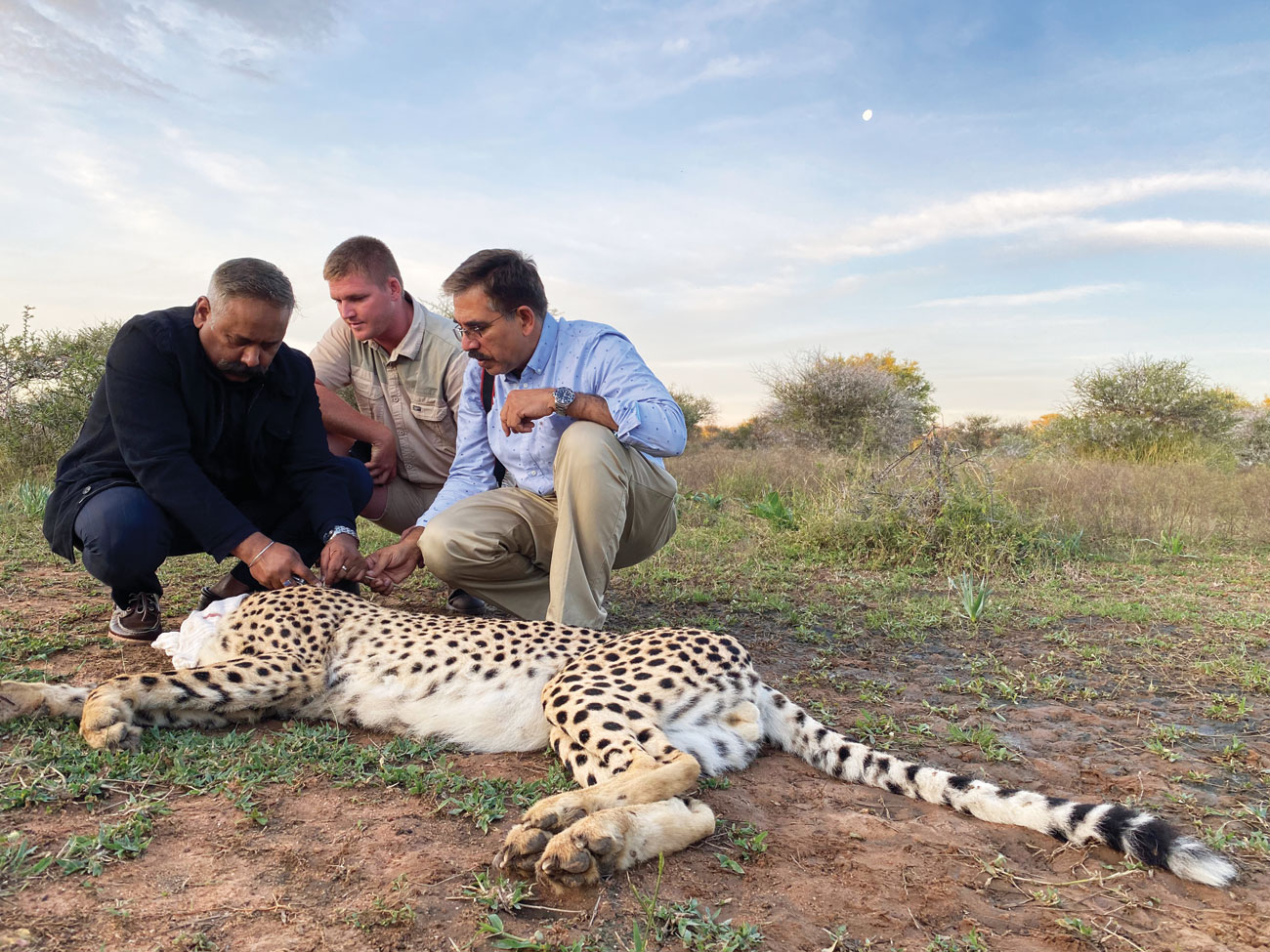
Amit Mallick, NTCA and Y. V. Jhala, WII, radio-collaring an anesthetised cheetah in South Africa as part of the cheetah metapopulation programme and training exercise before translocation to India. Photo Courtesy: Dr. Y.V. Jhala.
A Trailblazing Project
Today human actions have impacted natural systems in some form or another. True wildernesses devoid of human influence, either terrestrial or in the oceans, are a myth. A major impact of humans in the Anthropocene is the reduction of species’ range and their total annihilation. The rate of species loss in our era is akin to the time of the mass extinction of the dinosaurs some 65 million years ago. Fortunately, nature has endowed our species with the intellect to understand and redress our impacts on the planet. Human aided restoration of species through reintroductions is an important arsenal in the toolbox of conservation biology.
The cheetah, the only large carnivore driven to extinction in independent India, between the 1950s and 1960s by human actions, therefore presented an ideal case for reintroduction. The project suffered a major setback in 2013 when the Hon’ble Supreme Court passed a judgement in favour of reintroduction of lions from Gujarat to Kuno National Park, Madhya Pradesh. In this judgement, the introduction of cheetahs from Africa into Kuno was considered illegal. However, based on an affidavit filed by the National Tiger Conservation Authority (NTCA) with assistance from conservationist and wildlife expert Dr. M. K. Ranjitsinh (Sanctuary Lifetime Service Award 2014) and the Wildlife Institute of India in 2014, the Apex Court permitted the introduction of the African cheetah on an experimental basis in 2020.
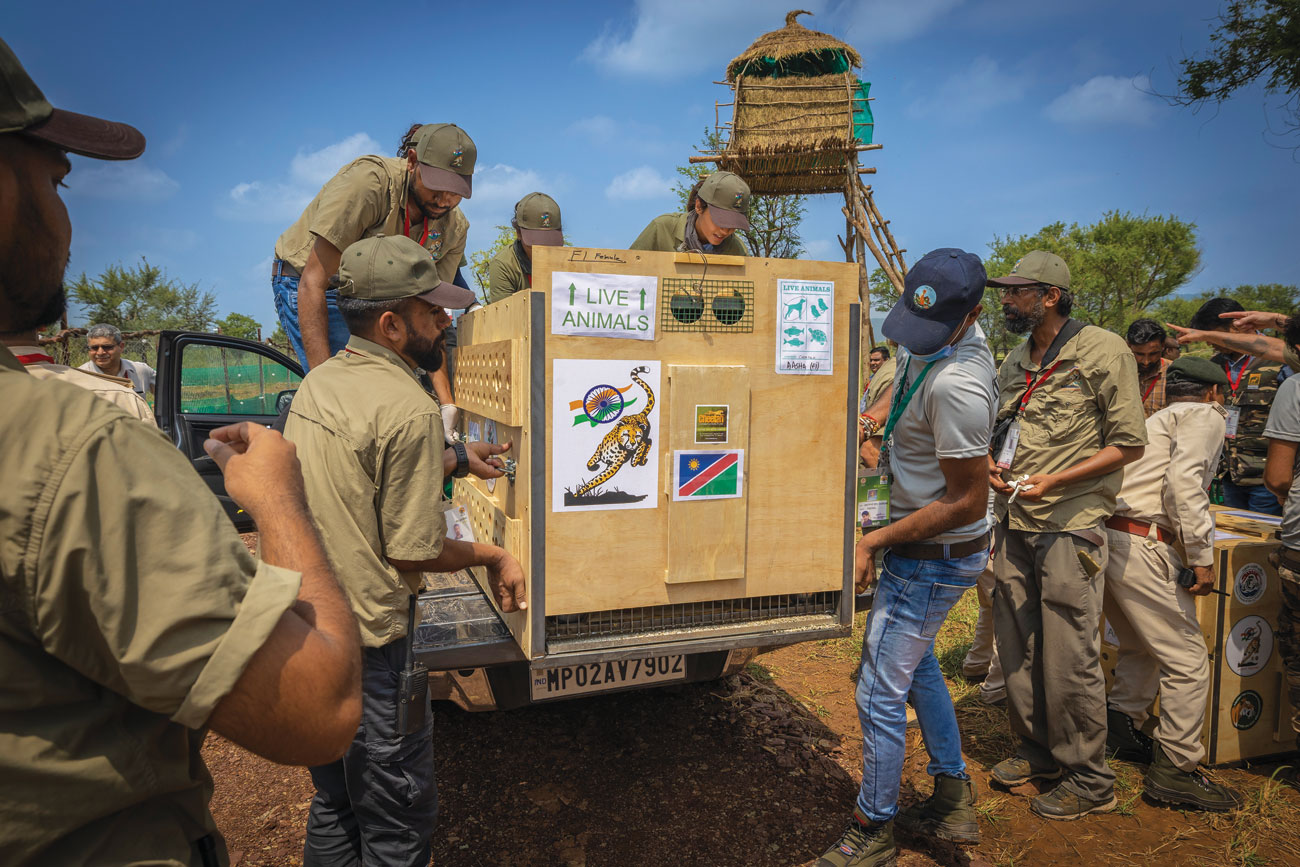
Team of researchers from the WII offloading cheetahs that arrived in specially-designed crates from Namibia at their quarantine facilities in the Kuno National Park. Photo: Shivang Mehta Photography Team.
Selecting A Source Population
Ideally, the Asiatic cheetah should have been reintroduced to India. However, the only surviving Asiatic cheetahs are in Iran and survive as a relict population of 15-20 individuals and are on the verge of extinction, highly inbred, and any removal would further endanger their survival, making them unavailable and unsuitable for the Indian reintroduction programme. In case the original race or subspecies is not available for reintroduction, the IUCN recommends using the closest genetic/ecological equivalent subspecies/race. The latest full genome sequence study of cheetahs across their historical range published in 2022 by Prost et al. in Molecular Ecology suggest that all cheetah sub-species are genetically equidistant from Acinonyx jubatus venaticus, the Asiatic cheetah subspecies. Thus, criteria other than genetics take precedence in selecting the source population for the Indian reintroduction. For establishing any new population of cheetahs, 30-40 individuals that are genetically diverse, disease free, can hunt, avoid predators and humans, are required. According to the guidelines of the IUCN, the only population of cheetahs that meet these criteria are from southern Africa. Between Namibia, South Africa and Botswana, there are about 4,000 cheetahs that can sustain an offtake of 30-40 individuals without negatively impacting the source population. In fact, the metapopulation of cheetahs maintained within fenced game reserves of South Africa has registered a growth rate of nine per cent over the past 10 years and the metapopulation managers are seeking reserves (space) to accommodate this rapidly growing population. Cheetahs in other parts of their range are declining. Just as in India, the wild cats have become locally extinct in 15 of their range countries since the 1940s. Their extant range is only nine per cent of the historical range. Thus, reintroduction of cheetahs into India contributes to the global goal of conserving the cheetah as a species by providing safe habitats for its expansion.
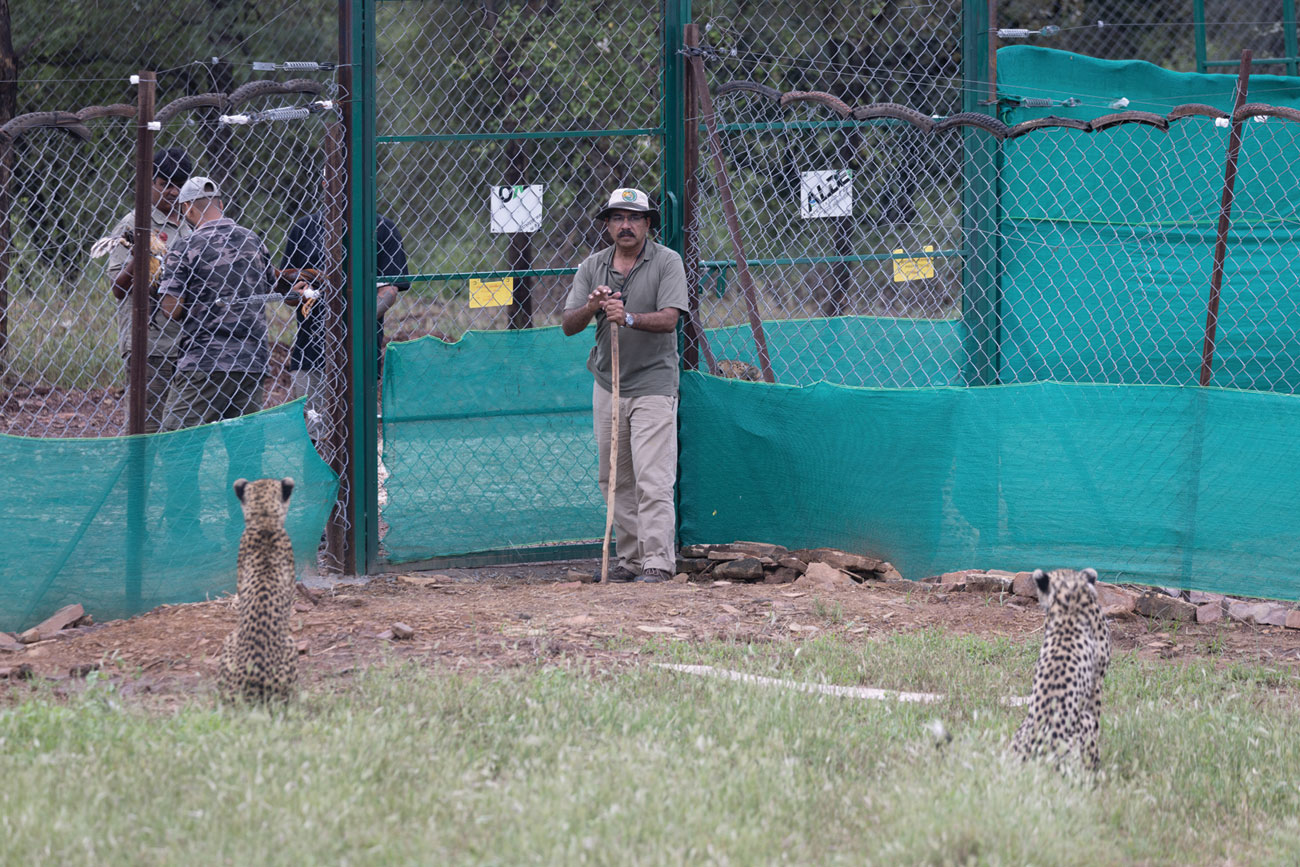
Cheetahs awaiting their feed in the bomas, a good time to evaluate their health and condition by close inspection. There is no record of a wild cheetah fatally attacking a human. Photo: Shivang Mehta Photography Team.
Ensuring A Safe Space
For sustaining a wide-ranging large carnivore, the site should have sufficient prey, habitat, and minimal human disturbance. These requirements ensure that large carnivores serve as umbrella species for biodiversity conservation. Indeed, the recovery of tigers across the forested landscapes of India has witnessed the recovery of many threatened species, as evidenced from the large-scale camera trap surveys conducted across India by the NTCA-WII-State Forest Departments every four years since 2008. The charisma of the cheetahs has captured the interest of political leaders and senior bureaucrats making government resources available for the restoration of savannah and open forest ecosystems. These biomes, along with their threatened biota have been neglected. We have failed miserably in trying to use the indigenous wolf, blackbuck, caracal, four-horned antelope, Lesser Florican and the Great Indian Bustard, as flagships to harness the required resources for the restoration and conservation of these systems. Requirements for the cheetah and the above-mentioned species are synonymous. Restoration investments required for introducing the cheetah are bound to benefit the entire biotic community of these ecosystems. The funds allocated for cheetah introduction are not at the cost of other species conservation programmes as is often touted. If funds allocated for restoring habitats and prey at proposed cheetah conservation reserves are not used for this purpose, then they would likely be used by the government for other purposes such as constructing roads or other infrastructure. Vast landscapes of Kuno, Gandhi Sagar, Nauradehi, and Shahgarh each ranging from 2,000 to 6,000 sq. km. would benefit from being declared as cheetah conservation reserves.
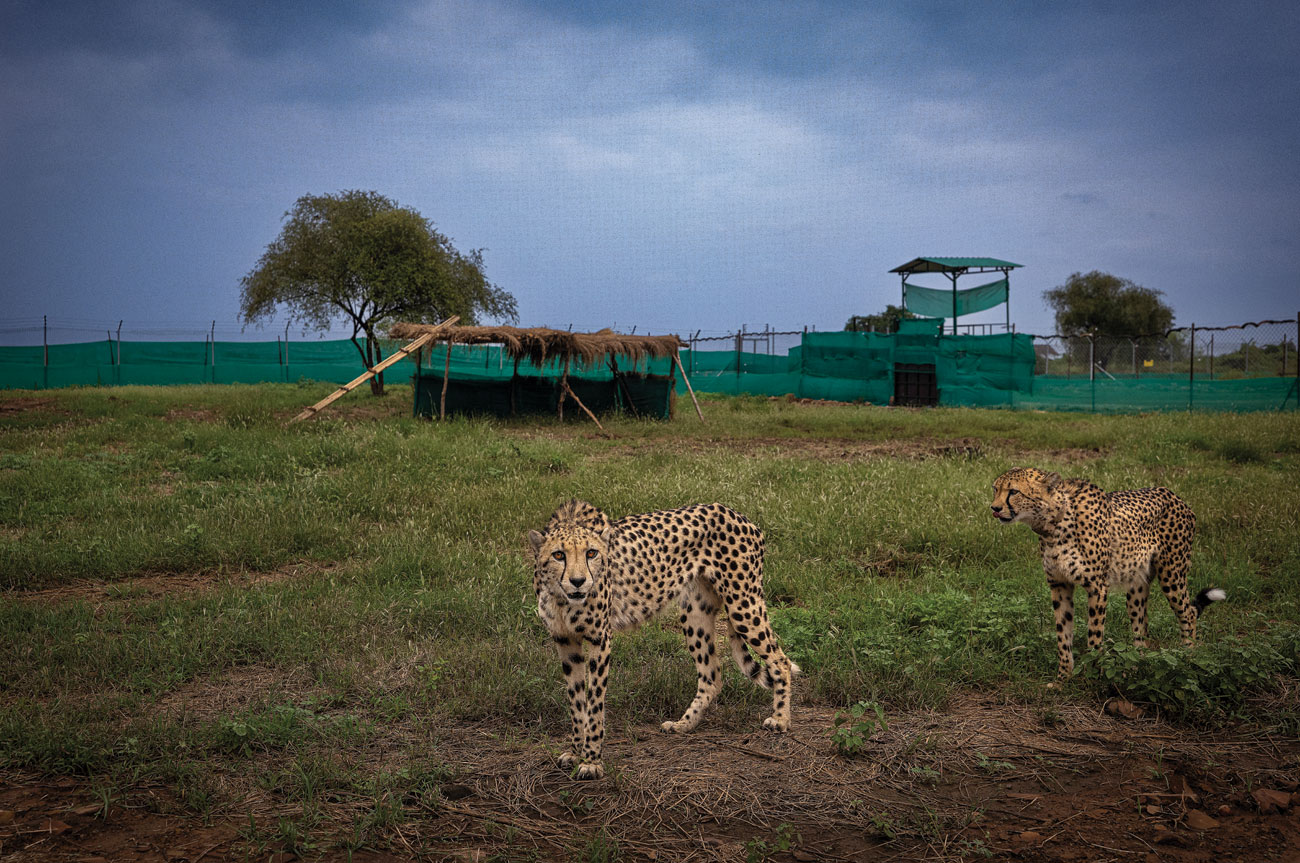
The first two cheetahs from the Cheetah Conservation Fund, Namibia, that were released by the Prime Minister of India on September 17, 2022 at Kuno National Park, in their quarantine boma. Photo: Shivang Mehta Photography Team.
The description of the cheetah in the Vedas and depictions in pre-historic cave paintings bear testimony of the species being an integral part of India’s ancient natural and cultural heritage. The word cheetah is of Sanskrit origin. Indeed, the cheetah was probably a major evolutionary force that shaped the speed of the blackbuck, which would have constituted its major prey. Reintroduction of the cheetah is not a new idea; it was discussed in the first meeting of the Indian Board of Wildlife in 1952. Today, the major threats that resulted in the extinction of the cheetah have been abated, and India now has the economic and scientific ability as well as the political will to bring back the species. In an international workshop in 2009 organised by the Wildlife Trust of India at Gajneer, conservation biologists, IUCN cat and reintroduction specialists, cheetah biologists, wildlife managers and policy makers from across the world met and discussed the possibility of reintroducing cheetahs to India. Based on the workshop’s outcome, the Ministry of Environment, Forests and Climate Change (MoEFCC) mandated me from the Wildlife Institute of India (WII) and Dr. M. K. Ranjitsinh, Chairman, Wildlife Trust of India (WTI) to scientifically evaluate the possibility of reintroducing cheetahs.
Chronology of Events
• Prehistoric cave paintings of cheetahs in Madhya Pradesh; mention of cheetah in Vedas and Puranas
• 1952: Cheetahs declared extinct in India
• 1970s: Discussions with the Shah of Iran regarding exchange of lions from Gujarat for Iranian cheetahs
• 2009: Gajneer Workshop on cheetah reintroduction
• 2010: Report on site evaluations – Ranjitsinh & Jhala 2010 (http://www.catsg.org/cheetah/05_library/5_3_publications/R/Ranjitsinh_&_Jhala_2010_Assessing_the_potential_for_
reintroducing_cheetah_in_Iran.pdf)
• 2013: Supreme Court judgement on lion reintroduction in Kuno, wherein introducing cheetahs from Africa was not permitted
• 2014: The National Tiger Conservation Authority (NTCA) files an affidavit requesting the Apex Court to reconsider their 2013 order with respect to cheetahs from Africa
• 2020: The Apex Court permits the introduction of cheetahs from Africa on an experimental basis
• 2021: Explorations, collaborations, and negotiations with Namibia and South Africa for sourcing of wild cheetahs. Action Plan for Cheetah Introduction to India released by Minister, MoEFCC https://wii.gov.in/images/images/documents/publications/action_plan_cheetah_introduction_jan_2022.pdf
• July 2022: Memorandum of Understanding signed with the Government of Namibia
• August 2022: Eight cheetahs including three free ranging ones, two from game reserves, and three wild caught orphans quarantined at the Cheetah Conservation Fund Facility in Otjiwarango, Namibia
• September 16-17, 2022: First batch of eight cheetahs from Namibia translocated to Kuno National Park by chartered flight and Indian Air Force helicopters, and released into a quarantine facility by the Prime Minister of India.
A Forest Awaits
Despite the Supreme Court order of 2013, Asiatic lions from Gujarat were not relocated to reach Kuno National Park. After a huge investment by the Central and State Governments and communities from 20 villages giving up their ancestral homes, Kuno was prepared to receive the lions. The legal status of a 350 sq. km. Kuno Wildlife Sanctuary was enhanced to a 748 sq. km. Kuno National Park embedded in a suitable habitat of over 6,000 sq. km. From an ungulate density of less than five per square kilometres in 2006, with stringent control of poaching and bioresource extraction, the ungulate density reached more than 45 sq. km. in 2014. However, by 2018, on account of delays in the reintroduction of lions from Gir, the motivation and incentive of Protected Area managers dwindled and Kuno National Park began to slip. Ungulate density dropped to ~30 sq. km., and poaching was evident in several parts of the park. The Hon’ble Supreme Court’s permission for the introduction of cheetahs from Africa to India was a shot in the arm for Kuno. Competent officers were appointed by the Madhya Pradesh government, enthusiasm surged again amongst park management. Resources were allocated, and to add to it, the Prime Minister of India came to Kuno to release the first cheetahs on Indian soil. Effective conservation can only happen if people will it to happen through the government. Kuno may have been the ideal site for a second home for Asiatic lions based on the opinion of conservation science, however, it is impossible to implement a reintroduction unless the government believes in it and owns it. Perhaps, conservation biologists failed to communicate the correct narrative in the case of lions to the government. Kuno needs the cheetahs just as much as Sariska needed tiger reintroduction for its survival. If cheetahs were not brought to Kuno, the national park would have deteriorated further. It is ideal when science guides conservation implementation, but conservation scientists need to learn to adapt, so as to gain the greatest grounds for conservation and not be lost in their dogma, which can be counterproductive for the cause.
Kuno’s habitat comprises a dry-deciduous open forest system, dominated by Anogeissus-Acacia thorn forests, mixed forests, open meadows (which were earlier agricultural fields), and riverine forests, making it one that is ideal for cheetahs, according to cheetah experts who visited and evaluated the site. The prey base primarily consists of chital, hare, peafowl, wild pigs, some four-horned antelope, chinkara, and young of sambar and nilgai. The potential for reintroducing blackbuck exists in plateau areas. In the absence of tigers and lions, the leopard is the apex predator and it occurs at a high density in Kuno. Cheetahs that are being reintroduced have had exposure to leopards in Africa (besides lions, spotted hyenas, and wild dogs) and should be able to cope with Kuno’s leopards. There will be losses of cheetahs (especially cubs) to leopards, snares set for bush meat, and other human-caused impacts; this is expected in any reintroduction programme and should not be cause for alarm but needs to be managed with law enforcement, community sensitisation and upliftment, and additional supplementation of cheetahs. There were speculations amongst critics that African cheetahs that have subsisted on antelope may not kill deer. This myth has already been proven wrong with the introduced cheetahs making regular kills of chital deer. Introduction of the cheetahs in no way compromises Kuno’s potential for housing lions and tigers. Actually, a top predator like the lion and tiger would help reduce the density of leopards in Kuno, thereby facilitating the establishment of the cheetahs.
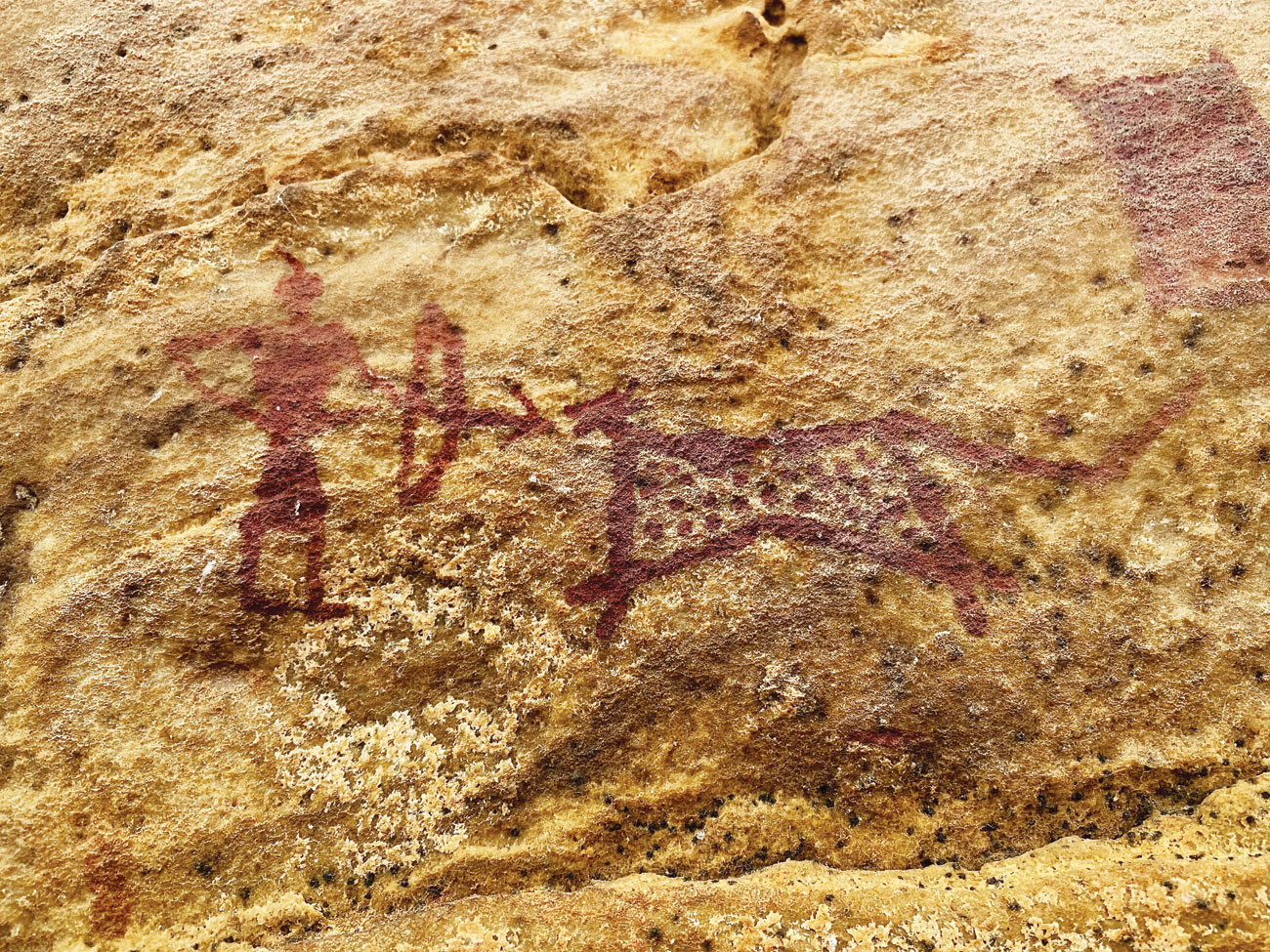
Prehistoric cave painting (older than 10,000 years) showing a cheetah with its characteristic body and tail shape at Chatrabhuj Nallaha in the Gandhi Sagar Wildlife Sanctuary, Madhya Pradesh. Photo: Dr. Y.V. Jhala.
A Changing Landscape
There has been a mad rush to purchase real estate in the vicinity of Kuno National Park. With the release of the first cheetahs by the Prime Minister, community land owners have become rich overnight, with some land prices shooting up almost a 100-fold! The Chief Minister of Madhya Pradesh in a public address at Kuno, before the arrival of the cheetahs, announced that lands of relocated villages from Kuno National Park will be gazetted as revenue villages, providing privileges of political self-governance and free sale. The Union Minister of Environment, Forest and Climate Change and senior bureaucrats visited peripheral villages, educating and sensitising adults and school children about cheetahs and their ecosystem. A cheetah mascot ‘Chintu Cheetah’ is used by the Forest Department to promote cheetah conservation. There is sufficient hype and goodwill for the cheetah in the local communities within the landscape and there is real potential for economic gain by them, provided policies are framed appropriately and in time. A landscape eco-tourism plan that promotes eco-sensitive and aesthetic tourism, where opportunities for local communities are safeguarded, needs to be urgently developed and implemented. Subsidies for purchasing safari vehicles, home-stays, training and certification of nature guides are some ways to ensure that livelihoods improve. The cheetah is a tourist magnet, and offers several opportunities that are not possible with other large carnivores. Unlike tigers, lions, and leopards that remain active at night, the cheetah is diurnal. Witnessing a cheetah hunt can be a life changing experience. Revenue from tourists, especially gate receipts of park entry should be shared with buffer zone communities, as is the norm for most
tiger reserves.
Goal of Cheetah Reintroduction
Establish a viable cheetah metapopulation in India that allows the cheetah to perform its functional role as a top predator and provides space for expansion within its historic range, thereby contributing to its global conservation efforts.
Objectives
1. To establish breeding cheetah populations in safe habitats across its historic range and manage them as a metapopulation.
2. To use the cheetah as a charismatic flagship and umbrella species to garner resources for restoring open forest and savanna systems that will benefit biodiversity and ecosystem services of these ecosystems.
3. To enhance India’s capacity to sequester carbon through ecosystem restoration activities in cheetah conservation areas and thereby contribute to global climate change mitigation goals.
4. To use the ensuing opportunity for eco-development and eco-tourism to enhance local community’s livelihoods.
5. To manage any conflict due to cheetahs or other wildlife with local communities within cheetah conservation areas expediently through compensation, awareness, and management actions to win community support
Lessons To Learn
The Cheetah Action Plan explicitly outlines the constraints of establishing viable cheetah populations in India. Reintroductions require long-term commitment of resources, continuous supply of appropriate animals from the source, and political will – which is currently the least restrictive. Vast wildernesses of several thousand square kilometres devoid of humans is impossible to secure in India. For that reason, several smaller populations need to be established and managed as a metapopulation. Eight cheetahs cannot establish a population, conservation science proposes importing 8-15 cheetahs each year for the next five to eight years to establish three to five different populations in India. Long-term viability of cheetahs in India is possible when these populations are established and managed together, just as is being done in South Africa. The difference between South African wildlife populations and wildlife in India is that in the former, wildlife is contained by physical barriers (electric fences) since local communities are intolerant; in India, physical barriers are replaced by fences of community tolerance. Lions, tigers, leopards and elephants move across human dominated landscapes through habitat corridors (albite with conflict). If conservationists and wildlife managers fail to establish community tolerance towards the cheetahs, then establishing cheetahs in India would fail. Cheetahs are comparatively easier to live with than tigers, lions, leopards and elephants. There is no record of a wild cheetah killing a human. Local communities around Kuno are used to living with leopards, and in the recent past with tigers. The cheetah project has adequate funds to pay compensation for any small livestock that is likely killed by cheetahs. However, mechanisms for prompt and fair payment will determine the success of this important mitigation measure.
An exemplary coexistence model is presented with lions and the people of Saurashtra. This model has much to teach the global conservation community about how people can live with large carnivores. The Gir Protected Area is too small to accommodate a viable lion population and 75 per cent of the 600 odd Asiatic lions share their habitat with people and their livestock. This coexistence is not without conflict, but on account of the cultural reverence for lions, a reasonable compensation scheme for livestock depredation by the Gujarat Forest Department, adaptive behaviour of lions (primarily scavenging livestock, avoiding peak human activity time, and using refuge habitats), and the huge economic benefits resulting from having lions in their neighbourhood, locals tolerate lions. Cheetahs have large home ranges and are likely to roam out of the Protected Areas into human-dominated parts of the landscape. Just like with the lions in Saurashtra, local people should be encouraged to see an opportunity here, cheetah viewing on private/public lands outside of the Protected Area can be a major source of revenue. If proper checks and balances are built from the beginning to legitimise such an activity, within the ambit of the Wildlife Protection Act, then the problems associated with locals taking liberties as has happened with lion shows in Saurashtra can be prevented. Once local communities experience the huge economic benefits emanating from cheetahs, loss of an occasional goat or sheep would not be an issue anymore. Such an approach would ensure that cheetahs flourish in India, beyond Protected Areas that would serve as breeding sources, and the larger human-dominated landscapes as sink and corridor habitats.
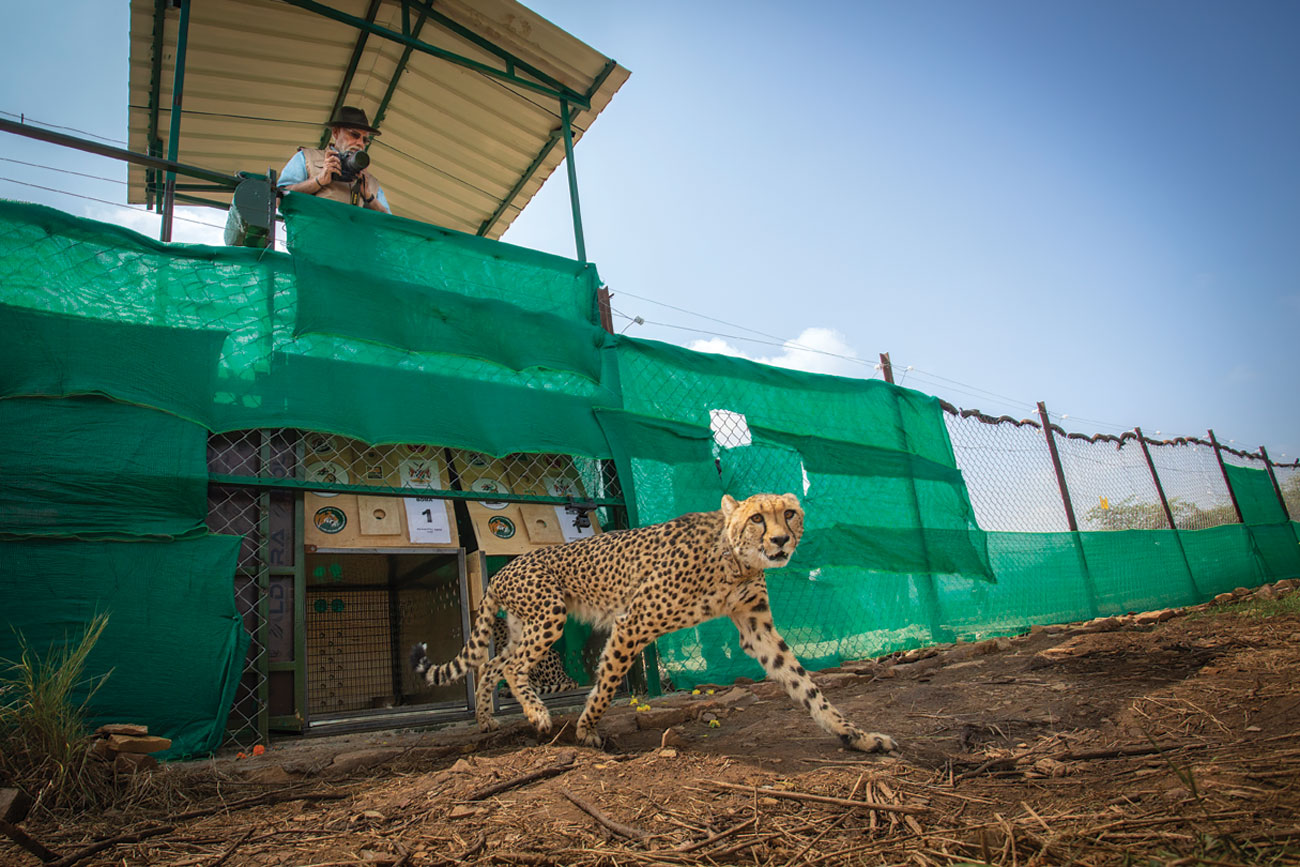
Shri Narendra Modi, the Prime Minister of India, looks on as the cheetah he released walks out into the quarantine boma from the crate it travelled in from Namibia to Kuno National Park in an epic transcontinental journey of 16 hours by road, plane, and helicopter. Photo: Shivang Mehta Photography Team.
The first cheetahs arrived from the quarantine facility of the Cheetah Conservation Fund, Otjiwarango, Namibia in Gwalior after a long 16-hour journey in a spectacular chartered plane with a painted tiger face – symbolic of a lost carnivore being restored in the land of the tiger! The cheetahs were accompanied by cheetah biologists, veterinarians, and managers from CCF Namibia, and South Africa and India. These experts used the best combination of transportation techniques and long-lasting anti-anxiety tranquilisers to ensure a safe, 100 per cent mortality-free transfer of the delicate cats that are known to be extremely vulnerable to stress. From Gwalior, two Airforce MI-17 helicopters (the least noisy of cargo choppers available with the Indian Airforce) flew them to the heart of Kuno National Park where a specially designed, soft release, predator-proof enclosure was built. Within this electrified fencing were built fortified quarantine bomas according to the specifications of the Disease Risk Assessment requirement by the IUCN and the Indian Department of Animal Husbandry and Dairying. It is here
that the first cheetahs were released on Indian soil by the Prime Minister of India.
This event heralds the successful first 10 per cent of this ambitious project. The actual test begins when these cheetahs and many others are made free ranging; their survival, reproduction, and recruitment will herald the successful establishment of one population. Cheetahs would be established in India when three to five such populations flourish and are managed as one metapopulation. No doubt a daunting task, but possible to achieve if executed as planned and proposed with adaptive management, over the long-term. Such an accomplishment would not only bring back an extinct, charismatic carnivore, but will also result in the restoration of several thousands of square kilometres of degraded dry forest-savanna, along with their ecosystem services of sequestering carbon, providing water, oxygen, and livelihoods to poverty-ridden communities. All this at the same cost that we spend to build a couple of concrete flyovers in our cities to reduce commute time from home to work. Is this not a bargain?
Shivang Mehta Photography Team: Allen Jacob, Parveen Chandila, Shivendra Gaur







